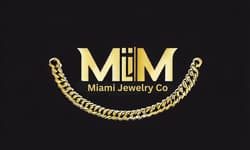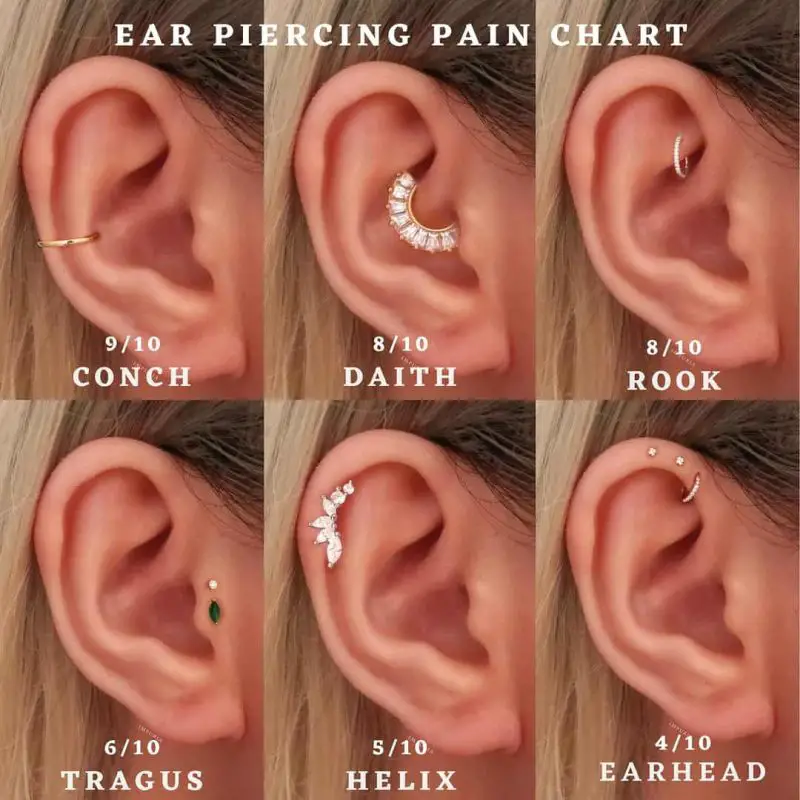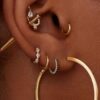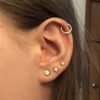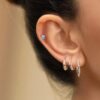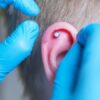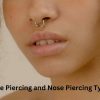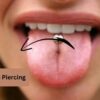Ear Piercing
Pain Ear Piercings Chart – 16 of the Least and Most Painful Types of Ear Piercings
Are you thinking of getting an ear piercing but not sure which one to choose?
Do you want to know how much pain you can expect from different types of ear piercings?
If so, you have come to the right place.
Ear piercing is a form of body modification that involves making a hole in the earlobe or cartilage and inserting a piece of jewelry. People get ear piercings for various reasons, such as expressing their personality, enhancing their appearance, following a cultural tradition, or joining a subculture.
There are many different types of ear piercings, each with its own name and location. Some of the most common ones are:
- Lobe: The standard piercing on the lower part of the earlobe
- Helix: The piercing on the upper part of the ear cartilage
- Daith: The piercing on the innermost part of the ear cartilage, near the ear canal
- Tragus: The piercing on the small flap of cartilage that covers the ear canal
- Conch: The piercing on the large area of cartilage that surrounds the ear canal
- Rook: The piercing on the fold of cartilage that separates the inner and outer conch
- Industrial: The piercing that connects two holes on the upper ear cartilage with a long barbell
- Snug: The piercing on the inner rim of the ear cartilage, opposite the tragus
- Anti-tragus: The piercing on the small flap of cartilage that lies below the tragus
- Forward helix: The piercing on the front part of the ear cartilage, near the face
- Orbital: The piercing that connects two holes on any part of the ear with a ring
- Transverse lobe: The piercing that goes horizontally through the earlobe
- Lobe orbital: The piercing that connects two holes on the lower part of the earlobe with a ring
- Scaffold: The piercing that connects two holes on any part of the ear with a long barbell
- Auricle: The piercing on the middle part of the ear cartilage, between the helix and the lobe
- Dermal punch: The piercing that removes a circular piece of cartilage or skin from any part of the ear.
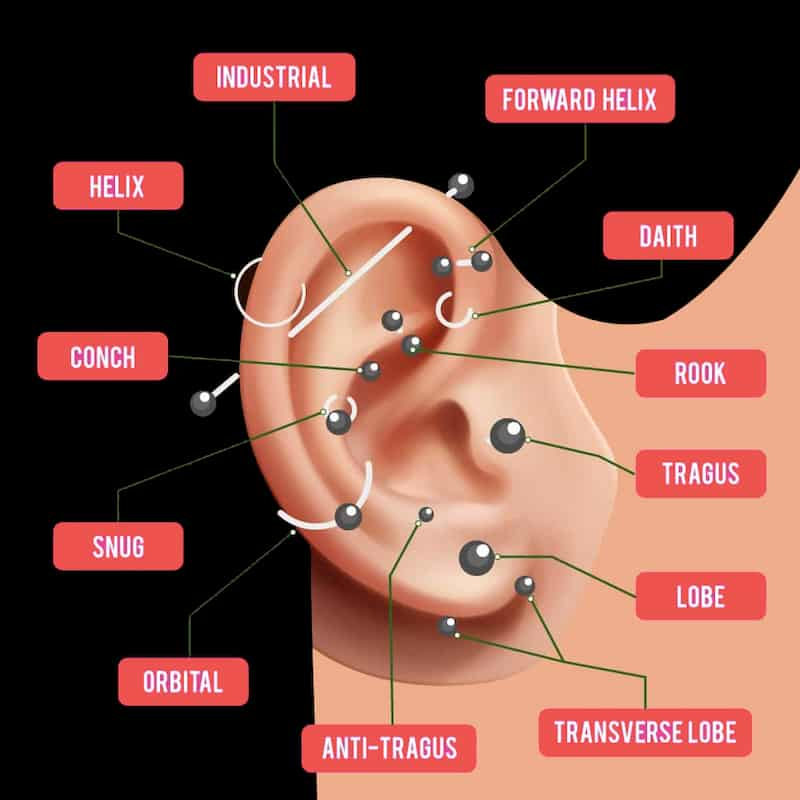
The main purpose of this article is to provide you with a pain chart for 16 common ear piercings and some tips on how to choose and care for them. By reading this article, you will learn:
- How to measure ear piercing pain and what factors affect it
- The pain level, healing time, and average cost of each ear piercing
- How to choose the best ear piercing for you based on your personal style, budget, lifestyle, health conditions, and pain threshold
- How to care for your new ear piercing and prevent infection or complications
So, let’s get started!
Contents
How to measure Ear Piercing pain
One of the most common questions people have before getting an ear piercing is how much it will hurt. Unfortunately, there is no definitive answer to this question, as pain is a subjective sensation that varies from person to person and from piercing to piercing.
However, there are some factors that can affect how much pain you feel when getting an ear piercing. These include:
- Needle size: The larger the needle, the more tissue damage and bleeding it will cause, which can increase pain.
- Piercing technique: The skill and experience of the piercer can make a difference in how smoothly and quickly they perform the procedure, which can reduce pain.
- Skin thickness: The thicker the skin or cartilage, the more resistance and pressure it will offer to the needle, which can increase pain.
- Nerve endings: The more nerve endings in an area, the more sensitive it will be to pain. Generally, areas closer to the face have more nerve endings than areas farther away.
- Individual pain tolerance: Some people are naturally more tolerant or resistant to pain than others. This can depend on factors such as genetics, hormones, mood, stress level, and previous experience with pain.
To help you estimate how much pain you can expect from different types of ear piercings, we have created a pain scale from 1 to 10, with 1 being the least painful and 10 being the most painful. Here are some examples of common sensations or activities that correspond to each pain level:
| Pain level | Example |
|---|---|
| 1 | A light pinch or scratch |
| 2 | A mosquito bite or a paper cut |
| 3 | A bee sting or a splinter |
| 4 | A minor burn or a toothache |
| 5 | A moderate headache or menstrual cramp |
| 6 | A sprained ankle or a broken finger |
| 7 | A severe migraine or kidney stone |
| 8 | A broken bone or childbirth |
| 9 | A gunshot wound or a stab wound |
| 10 | The worst pain imaginable |
Of course, these examples are not meant to be exact or universal, but rather to give you a general idea of how different levels of pain feel. Keep in mind that the pain you feel during the piercing procedure is usually brief and temporary, lasting only a few seconds or minutes. The pain you feel after the piercing is usually dull and throbbing, lasting for a few days or weeks.
- Related: Ear Piercing Ideas for Small Ears
The Pain Chart for 16 ear piercings
Now that you have an idea of how to measure ear piercing pain, let’s take a look at the pain chart for 16 common ear piercings. This chart will show you the location, pain level, healing time, and average cost of each ear piercing.
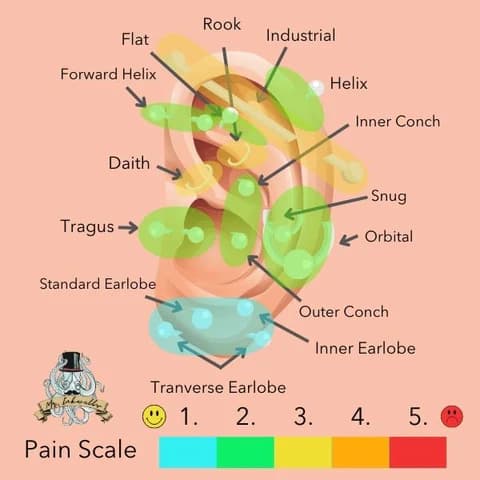
Here is the table:
Ear Piercings Pain Comparison Table
| Piercing Name | Piercing Location | Pain Scale | Healing Time | Average Cost |
|---|---|---|---|---|
| Earlobe | Bottom of the earlobe | 1/10 | 6 to 8 weeks | $10 to $50 |
| Upper Lobe | The inner part of the outer rim of the ear, where the cartilage folds over the conch. | 2/10 | 6 to 8 weeks | $10 to $50 |
| Helix | The front part of the upper rim of the ear | 3/10 | 3 to 6 months | $20 to $60 |
| Forward Helix | The upper part of the earlobe | 4/10 | 3 to 6 months | $20 to $60 |
| Auricle | The upper rim of the ear | 4/10 | 3 to 6 months | $20 to $60 |
| Transverse Lobe | Horizontally through the earlobe | 4/10 | 6 to 8 weeks | $20 to $60 |
| Conch | The outer edge of the ear | 5/10 | 6 to 12 months | $30 to $80 |
| Daith | The inner part of the ear | 6/10 | 6 to 12 months | $30 to $80 |
| Tragus | The innermost part of the ear cartilage | 6/10 | 3 to 6 months | $30 to $80 |
| Antitragus | Small flap of cartilage that protrudes above the earlobe | 7/10 | 3 to 6 months | $30 to $80 |
| Rook | A small flap of cartilage that covers the entrance of the ear canal | 7/10 | 6 to 12 months | $30 to $80 |
| Industrial | The upper part of the inner ear cartilage | 8/10 | 6 to 12 months | $40 to $100 |
| Snug | Inner part of the outer rim of the ear, where the cartilage folds over the conch. | 9/10 | 6 to 12 months | $40 to $100 |
| Orbital | Any part of the ear where two holes are made and connected by a single ring. | 9/10 | 6 to 12 months | $40 to $100 |
The Anatomy of the Ear and Pain Perception
The ear comprises three primary parts: the outer ear, the middle ear, and the inner ear. Within the outer ear are the pinna (the externally visible portion of the ear), the ear canal, and the eardrum. The middle ear contains three tiny bones called ossicles that transmit sound vibrations from the eardrum to the inner ear. The inner ear contains the cochlea (a spiral-shaped organ that converts sound waves into nerve impulses) and the vestibular system (a set of fluid-filled chambers that control balance and movement).
The outer ear is mostly made up of cartilage, which is a flexible connective tissue that provides shape and support to various parts of the body. Cartilage has no blood vessels or nerves, which means it does not bleed or feel pain when pierced. However, cartilage is surrounded by a thin layer of skin that does have blood vessels and nerves, which means it can bleed and feel pain when pierced.
The inner ear is mostly made up of nerve endings that are very sensitive to stimulation. Piercing the inner ear can cause severe pain, bleeding, infection, nerve damage, hearing loss, or vertigo (a sensation of spinning or dizziness). Therefore, piercing the inner ear is not recommended and should only be done by a qualified professional.
The pain level of different ear piercings depends on how much cartilage or nerve endings are involved in the piercing process. Generally speaking, piercings that involve more cartilage tend to be less painful than piercings that involve more nerve endings. However, this is not always the case, as some piercings may have other factors that affect their pain level, such as their size, depth, type, or location.
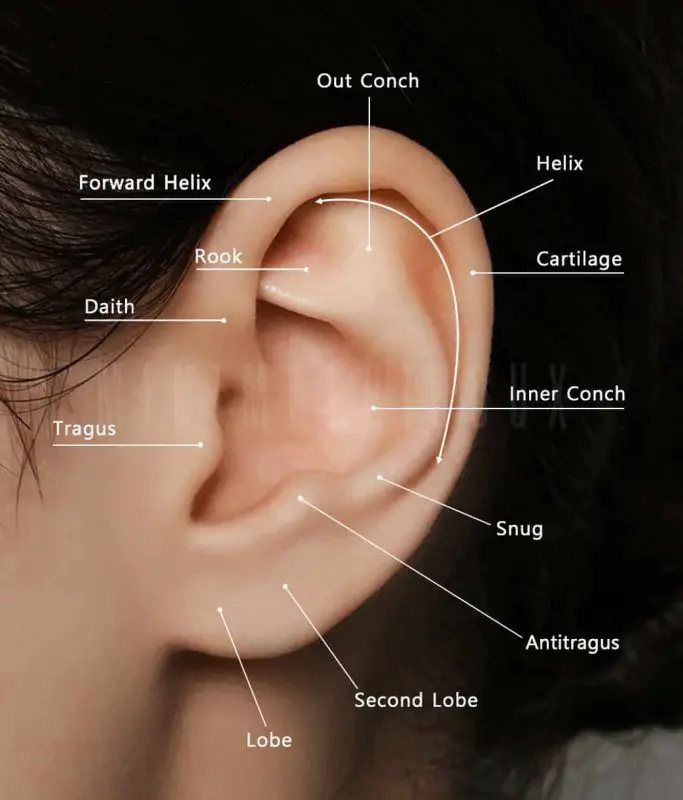
16 of the Least and Most Painful Types of Ear Piercings
The Least Painful Ear Piercings
The following are some of the least painful ear piercings that involve mostly cartilage or minimal nerve endings.
Earlobe Piercings
Earlobe piercings are one of the most common and oldest forms of ear piercings. They involve piercing through the soft tissue at the bottom of the earlobe. Earlobe piercings are usually done with a piercing gun or a needle.
- Piercing Location: Bottom of the earlobe
- Pain Scale: 1/10
- Healing Time: 6 to 8 weeks
- Average Cost: $10 to $50
Earlobe piercings are the least painful ear piercings because they have very few nerve endings and blood vessels. They also heal quickly and easily, as long as they are cleaned and cared for properly. Earlobe piercings can accommodate a wide range of jewelry styles, such as studs, hoops, rings, or dangling earrings.
Upper Lobe Piercings
Upper lobe piercings are similar to earlobe piercings, except they are done higher up on the earlobe, closer to the cartilage. Upper lobe piercings are also done with a piercing gun or a needle.
- Piercing Location: Upper part of the earlobe
- Pain Scale: 2/10
- Healing Time: 6 to 8 weeks
- Average Cost: $10 to $50
Upper lobe piercings are slightly more painful than earlobe piercings because they are closer to the cartilage, which has more nerve endings and blood vessels. Nonetheless, they remain fairly painless and straightforward to recover from. Upper lobe piercings can also accommodate a variety of jewelry styles, such as studs, hoops, rings, or dangling earrings.
Helix Piercings
Helix piercings are done on the upper rim of the ear, where the cartilage curves inward. Helix piercings are usually done with a needle or a piercing gun.
- Piercing Location: Upper rim of the ear
- Pain Scale: 3/10
- Healing Time: 3 to 6 months
- Average Cost: $20 to $60
Helix piercings are more painful than earlobe or upper lobe piercings because they involve piercing through the cartilage, which is harder and thicker than the soft tissue of the earlobe. However, they are still relatively painless compared to other ear piercings. Helix piercings can take longer to heal because cartilage has less blood supply and oxygen than soft tissue. Helix piercings can be adorned with various jewelry styles, such as studs, hoops, rings, or barbells.
Forward Helix Piercings
Forward helix piercings are done on the front part of the upper rim of the ear, where the cartilage meets the face. Forward helix piercings are usually done with a needle or a piercing gun.
- Piercing Location: Front part of the upper rim of the ear
- Pain Scale: 4/10
- Healing Time: 3 to 6 months
- Average Cost: $20 to $60
Forward helix piercings are slightly more painful than helix piercings because they are closer to the face, which has more nerve endings and blood vessels. However, they are still relatively painless compared to other ear piercings. Forward helix piercings can also take longer to heal because of the cartilage’s low blood supply and oxygen. Forward helix piercings can be decorated with various jewelry styles, such as studs, hoops, rings, or barbells.
Auricle Piercings
Auricle piercings are done on the outer edge of the ear, between the helix and the earlobe. Auricle piercings are usually done with a needle or a piercing gun.
- Piercing Location: Outer edge of the ear
- Pain Scale: 4/10
- Healing Time: 3 to 6 months
- Average Cost: $20 to $60
Auricle piercings are similar in pain level to helix or forward helix piercings because they involve piercing through the cartilage, which is harder and thicker than the soft tissue of the earlobe. However, they are still relatively painless compared to other ear piercings. Auricle piercings can also take longer to heal because of the cartilage’s low blood supply and oxygen. Auricle piercings can be embellished with various jewelry styles, such as studs, hoops, rings, or barbells.
Transverse Lobe Piercings
Transverse lobe piercings are done horizontally through the earlobe, creating a bar-like effect. Transverse lobe piercings are usually done with a needle or a piercing gun.
- Piercing Location: Horizontally through the earlobe
- Pain Scale: 4/10
- Healing Time: 6 to 8 weeks
- Average Cost: $20 to $60
Transverse lobe piercings are slightly more painful than earlobe or upper lobe piercings because they involve piercing through more tissue and creating a larger wound. However, they are still relatively painless compared to other ear piercings. Transverse lobe piercings heal quickly and easily, as long as they are cleaned and cared for properly
Moderate Pain Ear Piercings
The following are some of the moderate pain ear piercings that involve a mix of cartilage and nerve endings.
Conch Piercings
Conch piercings are done on the inner part of the ear, where the cartilage forms a bowl-like shape. Conch piercings can be either inner or outer, depending on whether they are done on the upper or lower part of the conch. Conch piercings are usually done with a needle or a dermal punch.
- Piercing Location: Inner part of the ear
- Pain Scale: 5/10
- Healing Time: 6 to 12 months
- Average Cost: $30 to $80
Conch piercings are more painful than helix, forward helix, auricle, or transverse lobe piercings because they involve piercing through a thicker and denser part of the cartilage, which has more nerve endings and blood vessels. However, they are still manageable compared to other ear piercings. Conch piercings can take longer to heal because of the cartilage’s low blood supply and oxygen. Conch piercings can be adorned with various jewelry styles, such as studs, hoops, rings, or barbells.
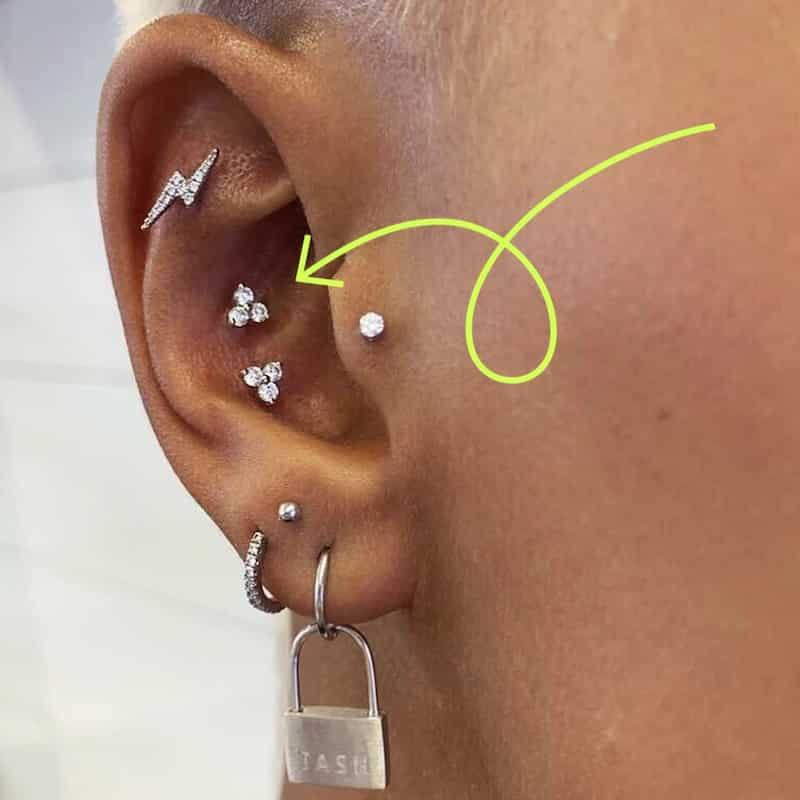
- Related: Orbital vs Conch Piercing
Daith Piercings
Daith piercings are done on the innermost part of the ear cartilage, where it folds over the ear canal. Daith piercings are usually done with a needle or a dermal punch.
- Piercing Location: Innermost part of the ear cartilage
- Pain Scale: 6/10
- Healing Time: 6 to 12 months
- Average Cost: $30 to $80
Daith piercings are more painful than conch piercings because they involve piercing through a very thick and hard part of the cartilage, which has more nerve endings and blood vessels. However, they are still tolerable compared to other ear piercings. Daith piercings can also take longer to heal because of the cartilage’s low blood supply and oxygen. Daith piercings can be decorated with various jewelry styles, such as hoops, rings, or barbells. Some people believe that daith piercings can help with migraines or anxiety, but there is no scientific evidence to support this claim.
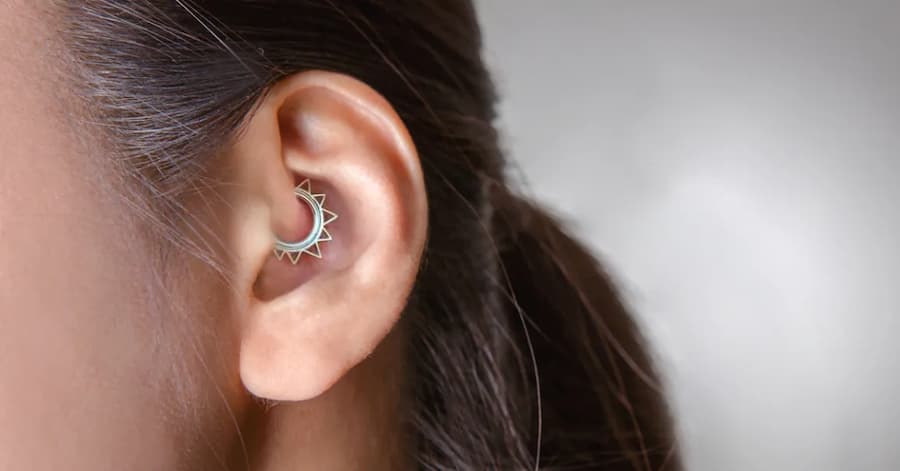
- Related: Rook Piercing vs Daith
Tragus Piercings
Tragus piercings are done on the small flap of cartilage that covers the entrance of the ear canal. Tragus piercings are usually done with a needle or a dermal punch.
- Piercing Location: Small flap of cartilage that covers the entrance of the ear canal
- Pain Scale: 6/10
- Healing Time: 3 to 6 months
- Average Cost: $30 to $80
Tragus piercings are more painful than conch or daith piercings because they involve piercing through a very sensitive and nerve-rich part of the ear, which is also close to the face. However, they are still bearable compared to other ear piercings. Tragus piercings can heal faster than conch or daith piercings because they have more blood supply and oxygen than other parts of the cartilage. Tragus piercings can be embellished with various jewelry styles, such as studs, hoops, rings, or barbells.

Antitragus Piercings
Antitragus piercings are done on the opposite side of the tragus, on the small flap of cartilage that protrudes above the earlobe. Antitragus piercings are usually done with a needle or a dermal punch.
- Piercing Location: Small flap of cartilage that protrudes above the earlobe
- Pain Scale: 7/10
- Healing Time: 3 to 6 months
- Average Cost: $30 to $80
Antitragus piercings are more painful than tragus piercings because they involve piercing through a thicker and harder part of the cartilage, which has more nerve endings and blood vessels. However, they are still manageable compared to other ear piercings. Antitragus piercings can heal faster than conch or daith piercings because they have more blood supply and oxygen than other parts of the cartilage. Antitragus piercings can be adorned with various jewelry styles, such as studs, hoops, rings, or barbells.
Rook Piercings
Rook piercings are done on the upper part of the inner ear cartilage, where it curves over the daith. Rook piercings are usually done with a needle or a dermal punch.
- Piercing Location: Upper part of the inner ear cartilage
- Pain Scale: 7/10
- Healing Time: 6 to 12 months
- Average Cost: $30 to $80
Rook piercings are more painful than antitragus piercings because they involve piercing through a very thick and hard part of the cartilage, which has more nerve endings and blood vessels. However, they are still tolerable compared to other ear piercings. Rook piercings can take longer to heal because of the cartilage’s low blood supply and oxygen. Rook piercings can be decorated with various jewelry styles, such as hoops, rings, or barbells.

The Most Painful Ear Piercings
The following are some of the most painful ear piercings that involve multiple piercings, complex angles, or high-risk areas.
Industrial Piercings
Industrial piercings are done on the upper rim of the ear, where two holes are made and connected by a single barbell. Industrial piercings are usually done with a needle or a piercing gun.
- Piercing Location: Upper rim of the ear
- Pain Scale: 8/10
- Healing Time: 6 to 12 months
- Average Cost: $40 to $100
Industrial piercings are more painful than rook piercings because they involve piercing through two parts of the cartilage, which has more nerve endings and blood vessels. They also create a larger wound and require more alignment and precision. However, they are still bearable compared to other ear piercings. Industrial piercings can take longer to heal because of the cartilage’s low blood supply and oxygen. They also require more care and attention, as they can be easily bumped or snagged by clothing, hair, or other objects. Industrial piercings can be adorned with various jewelry styles, such as barbells, chains, or charms.
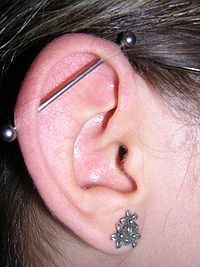
Snug Piercings
Snug piercings are done on the inner part of the outer rim of the ear, where the cartilage folds over the conch. Snug piercings are usually done with a needle or a dermal punch.
- Piercing Location: Inner part of the outer rim of the ear
- Pain Scale: 9/10
- Healing Time: 6 to 12 months
- Average Cost: $40 to $100
Snug piercings are more painful than industrial piercings because they involve piercing through a very thick and hard part of the cartilage, which has more nerve endings and blood vessels. They also require more force and pressure to penetrate the cartilage. However, they are still manageable compared to other ear piercings. Snug piercings can take longer to heal because of the cartilage’s low blood supply and oxygen. They also require more care and attention, as they can be easily irritated or infected by dirt, sweat, or bacteria. Snug piercings can be adorned with various jewelry styles, such as hoops, rings, or barbells.

Orbital Piercings
Orbital piercings are done on any part of the ear where two holes are made and connected by a single ring. Orbital piercings can be done on the helix, conch, daith, tragus, antitragus, rook, or snug. Orbital piercings are usually done with a needle or a dermal punch.
- Piercing Location: Any part of the ear where two holes are made and connected by a single ring
- Pain Scale: 9/10
- Healing Time: 6 to 12 months
- Average Cost: $40 to $100
Orbital piercings are more painful than snug piercings because they involve piercing through two parts of the ear, which may have different levels of sensitivity and thickness. They also create a larger wound and require more alignment and precision. However, they are still tolerable compared to other ear piercings. Orbital piercings can take longer to heal because of the low blood supply and oxygen of the cartilage. They also require more care and attention, as they can be easily bumped or snagged by clothing, hair, or other objects. Orbital piercings can be adorned with various jewelry styles, such as rings, chains, or charms.
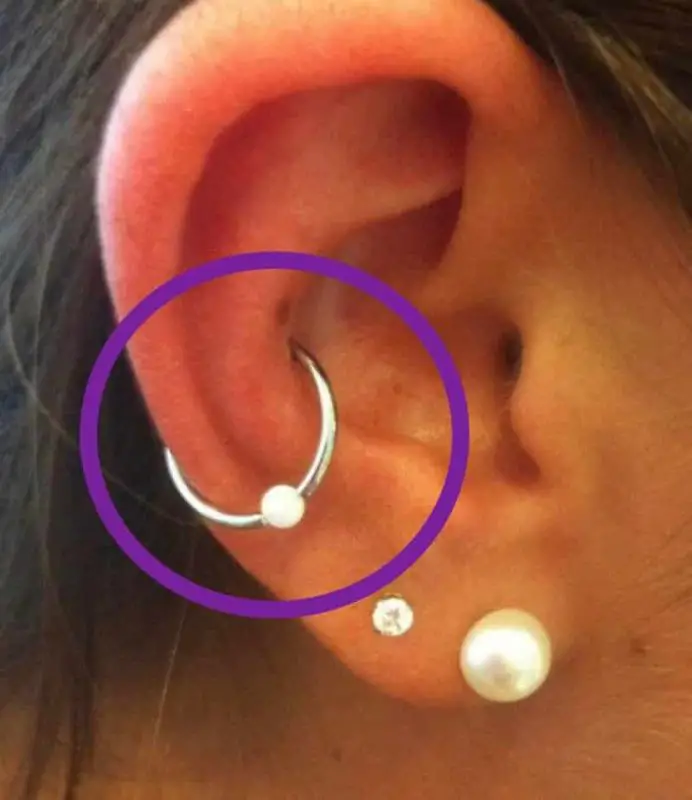
Vertical Industrial Piercings
Vertical industrial piercings are done on the upper part of the inner ear cartilage, where two holes are made vertically and connected by a single barbell. Vertical industrial piercings are usually done with a needle or a dermal punch.
- Piercing Location: Upper part of the inner ear cartilage
- Pain Scale: 10/10
- Healing Time: 6 to 12 months
- Average Cost: $40 to $100
Vertical industrial piercings are more painful than orbital piercings because they involve piercing through two very thick and hard parts of the cartilage, which have more nerve endings and blood vessels. They also create a larger wound and require
Factors Influencing Piercing Pain
The Piercer’s Technique
The hand behind the needle plays a significant role in the amount of pain you might feel. Let’s discuss why.
- How experience plays a role: An experienced piercer knows exactly where to place the needle, ensuring minimal damage to tissue and nerves. They also have the know-how on the right angle and pressure required for each piercing, making the process smoother and quicker. It’s like comparing a seasoned chef’s knife skills to a newbie’s; precision matters!
- The importance of choosing the right studio: Not all piercing studios are created equal. The right studio adheres to high hygiene standards, uses sterilized equipment, and employs seasoned professionals. Moreover, the studio ambiance itself can play a role in calming your nerves. You don’t want to walk into a dimly lit, cluttered space, right? A clean, professional environment not only reduces risks of infection but also ensures a more pleasant overall experience.
Individual Pain Threshold
Our bodies and minds are unique, and so is the way we perceive pain. Let’s understand this better.
- How personal experiences vary: Some of us flinch at a mere pinch, while others may barely bat an eye. Past experiences, including prior piercings or other painful events, can shape our pain threshold. For instance, someone who’s endured numerous piercings might find the process less painful than a first-timer.
- The mind’s role in pain perception: Our mental state heavily influences how we perceive pain. Anxiety, fear, or anticipation can heighten sensitivity, making us feel more pain. Conversely, being calm and composed, or even excited, can make the experience more bearable.
Tips to Reduce Piercing Pain
Numbing Creams and Gels
Piercing, for many, is a blend of excitement and anxiety. The thought of the pain involved might be daunting. Thankfully, there are ways to lessen the discomfort.
- Their efficacy: Numbing creams and gels are topical anesthetics that can dull the skin’s sensation temporarily. Ingredients like lidocaine in these products block pain signals, ensuring a more comfortable piercing experience.
- Recommendations: If you’re considering numbing products, discuss it with your piercer first. They can recommend reputable brands or advise on the right application method. Remember to apply as directed, usually 30 minutes to an hour before the procedure, to ensure maximum efficacy.
Proper Aftercare
Just like nurturing a plant helps it flourish, taking care of your piercing can lead to faster healing and reduced pain.
- How this can alleviate prolonged pain: When a piercing is left unattended, the chances of infection and swelling increase. This not only prolongs the healing period but can also intensify the pain. Proper aftercare ensures the wound remains clean and any harmful bacteria are kept at bay.
- Recommendations for keeping piercings clean:
- Saline Solution: A mixture of salt and warm water can be used to clean the piercing. This homemade solution mimics your body’s natural salinity, reducing irritation.
- Avoid Touching: I can’t stress this enough; avoid playing with or unnecessarily touching your piercing. Your hands harbor bacteria that could cause infections.
- Stay Away from Alcohol and Hydrogen Peroxide: These might be great for minor cuts but for piercings. They can be too harsh, causing irritation.
Common Myths About Piercing Pain
We live in an era of information overload. But not everything you read or hear is gospel truth, especially when it comes to piercings.
- Debunking common misconceptions: “More painful piercings heal faster.” Not true. Pain levels don’t determine healing time.
- “Piercing guns are better than needles.” Wrong again. Needles are usually safer and cause less trauma to the skin.
Understanding the facts: It’s crucial to differentiate myths from facts. Instead of relying on hearsay or anecdotes, trust expert advice or credible sources.
FAQs Related to Ear Piercings Pain Chart
Why do some ear piercings hurt more than others?
Different parts of the ear have varying nerve concentrations and types of tissue. Piercings that go through cartilage or dense nerve areas might be more painful than those through softer tissues.
Which ear piercing is most painful?
The pain level of ear piercings varies from person to person, but many find that the conch, rook, and daith piercings are among the more painful ear piercings. This is due to the fact that these areas involve piercing through thicker cartilage compared to other ear areas. The industrial piercing, which goes through two points in the ear’s cartilage, can also be particularly painful for some.
What are the 3 most painful piercings?
Many find nipple, genital, and industrial ear piercings to be very painful.
Which ear hurts less to pierce?
Pain tolerance varies among individuals, and there’s no definitive evidence to suggest that one ear universally hurts less than the other to pierce. The pain is more about the specific location of the piercing on the ear (lobe vs. cartilage) than which ear is pierced. Generally, earlobe piercings are less painful than cartilage piercings.
How long will your ears hurt after piercing?
It’s different for everyone. But piercings in the soft part of the ear (the lobe) usually hurt less than the harder parts.
Which ear piercing is for anxiety?
The daith piercing is sometimes believed to help with anxiety. This belief stems from the idea that the piercing targets an acupressure point associated with anxiety relief. However, it’s crucial to note that scientific evidence supporting this claim is limited. While some individuals report relief, it may also be due to placebo effect.
Which piercing is for depression?
No piercing is proven to help with depression. It’s always best to talk to a doctor about feelings of sadness.
What piercing helps with sleep?
Some say the daith piercing can help if you have trouble sleeping due to headaches. But it’s not proven.
How long does the pain last after getting an ear piercing?
The initial sharp pain is momentary, but soreness or dull pain can persist for days to weeks, depending on the piercing type and individual healing factors.
Is there a best time or age to get specific ear piercings?
While there’s no ‘perfect’ age, it’s crucial to be mature enough to understand the commitment and aftercare involved.
Can my ear anatomy impact my piercing pain?
Absolutely. The thickness and structure of your ear can influence pain levels. Everyone’s anatomy is unique, and what’s comfortable for one person might be painful for another.
Final Words – Pain Ear Piercings Chart
Ear piercings, an ancient art form, have adorned humans for millennia. While they can be a beautiful expression of individuality, it’s essential to understand that pain is subjective. The way I perceive pain could be worlds apart from how you feel. Preparedness, both mentally and in terms of aftercare, can make a world of difference in your piercing journey.
Reference:

Camila Luna is a passionate jewelry enthusiast and content creator at Miami Jewelry Co. With a focus on providing high-quality, Miami-style jewelry, Camila and her team specialize in a wide range of jewelry that includes bracelets, necklaces, earrings, and more
